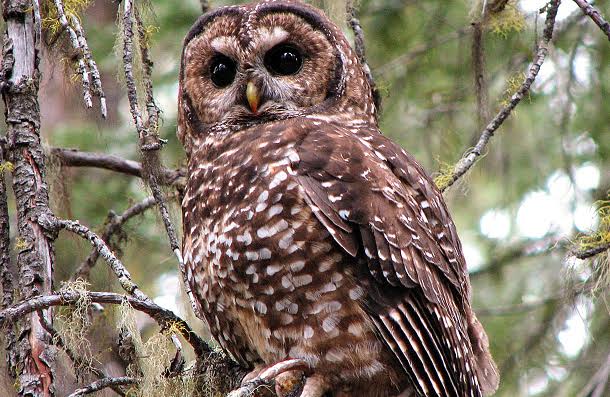Northern Spotted Owl Populations in Rapid Decline, New Study Reports

Northern Spotted Owl by Chris Warren
Contact: Steve Holmer, American Bird Conservancy, 202-888-7490
(Washington, DC, December 10, 2015) The Northern Spotted Owl is in decline across its entire range, and its rate of decline is increasing—that is the conclusion of a major demographic study produced by federal scientists, published Wednesday, December 9, 2015, in the journal “The Condor.” The study examined survey results from monitoring areas across the range of the imperiled owl.
This research indicates that since monitoring began in 1985, Spotted Owl populations declined 55-77 percent in Washington, 31-68 percent in Oregon, and 32-55 percent in California. In addition, population declines are now occurring in study areas in southern Oregon and northern California that were previously experiencing little to no detectable decline through 2009.
“This study confirms that immediate action is needed to reduce the impact of Barred Owls and to protect all remaining Spotted Owl habitat. It also points to the need to restore additional habitat by maintaining and expanding the successful reserve network of the Northwest Forest Plan,” said Steve Holmer, senior policy advisor with American Bird Conservancy.
While habitat loss continues to threaten the Spotted Owl, new threats have emerged. Barred Owls, whose range has increased in recent years to coincide with the Northern Spotted Owl, can outcompete the Spotted Owl for food and territory. The study says:
We observed strong evidence that Barred Owls negatively affected Spotted Owl populations, primarily by decreasing apparent survival and increasing local territory extinction rates. … In the study areas where habitat was an important source of variation for Spotted Owl demographics, vital rates were generally positively associated with a greater amount of suitable owl habitat.
However, Barred Owl densities may now be high enough across the range of the Northern Spotted Owl that, despite the continued management and conservation of suitable owl habitat on federal lands, the long-term prognosis for the persistence of Northern Spotted Owls may be in question without additional management intervention.
The Importance of Spotted Owl Habitat
Dr. Katie Dugger, a research biologist at the USGS Oregon Cooperative Fish and Wildlife Research Unit of Oregon State University and lead author on the report, said: “The amount of suitable habitat required by Spotted Owls for nesting and roosting is important because Spotted Owl survival, colonization of empty territories, and number of young produced tends to be higher in areas with larger amounts of suitable habitat, at least in some study areas."
Much attention has turned to the increased threat posed by Barred Owls since the Northern Spotted Owl was listed as a threatened species under the Endangered Species Act in 1990. However, Holmer stressed that adequate habitat is the only long-term solution to the Barred Owl threat.
“Science shows that Northern Spotted Owls and Barred Owls can coexist where there is enough high-quality habitat,” he said. “A large amount of owl habitat will become available as the Northwest Forest Plan continues to restore the old-growth ecosystem.”
Northern Spotted Owl & the Northwest Forest Plan
The Northern Spotted Owl is a rare raptor often associated with the complex features and closed canopy of mature or old-growth forests. Since it is associated with older forests, the owl serves as an “indicator species”—its presence indicates that the forest is healthy and functioning properly.
Historically, Spotted Owl decline has been traced to habitat loss caused primarily by logging. Because the owl is dependent on older forest types, logging of old-growth forests is particularly harmful. Once these forests are logged, it can take many decades before suitable habitat regrows.
The Northern Spotted Owl's 1990 listing intensified issues concerning federal forest management. As a consequence of prior overcutting of owl habitat and a lack of compliance by the land-management agencies with wildlife protection requirements, logging of federal forests was largely halted across the owl's range.
In reaction to the stalemate over federal forest management, in 1994, the Clinton Administration established the Northwest Forest Plan, a landscape-level resource management plan that established a series of forest reserves across the range of the Northern Spotted Owl. The plan was intended to both protect remaining owl habitat and to encourage development of future habitat.
After 20 years, USDA Forest Service monitoring reports indicate the plan is meeting its objectives to restore wildlife habitat as well as to improve water quality; forests of the Northwest are also now storing carbon instead of acting as a source of emissions.
“The monitoring reports confirm that the system of reserves has slowed the decline of the owl,” Holmer said. “But the Spotted Owl's continued decline makes clear that this reserve system is not enough due to competition from Barred Owls. Urgent action is needed to address the Barred Owl threat and to protect all Spotted Owl habitat on federal land.”
(Read our previous release about the need for the Northern Spotted Owl to be listed as an Endangered species.)


















































